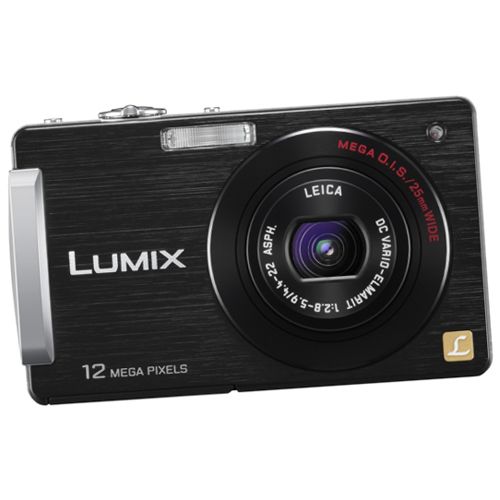Though an attractive brushed metal faceplate and solid build distracts from its otherwise boxy dimensions, Panasonic’s latest Lumix FX550 point and shoot is certainly one of the more conventionally styled yet premium priced compacts (at £294 SRP) we’ve seen of late. Especially coming after Sony’s slim-line Cyber-shot T90 and Canon IXUS 110 IS rivals. That said, at a width of just 21.9mm with lens retracted, it still slips comfortably into any trouser pocket or handbag.
Our quick take
If conditions are sufficiently clement the Panasonic FX550 proves itself a reliable performer, consistently delivering colourful even exposures. However it’s not immune to pixel fringing on close inspection and white balance occasionally biasing whatever colour is dominant in the scene to the expense of others.
More positively the Leica lens ensures that detail is sharp and crisp too.
The overall impression is that once again it’s a case of maximum return from minimal user effort with little if any post processing required via image editing software.
For the occasional traveller looking for a sturdily built pocket snapper that will withstand the odd knock and scratch the Lumix DMC-FX550 therefore comes recommended.

Panasonic Lumix DMC-FX550 digital camera - 4.0 / 5
| FOR | AGAINST |
|---|---|
|
|
Given that its traditional design carries over to the FX550’s back plate, where we find a familiar smattering of disappointingly plastic buttons ranged right of its 3-inch, 230k dot LCD, it’s a surprise to find said screen incorporates touch operation. The camera’s shooting and review modes are revealed as reactive lozenge-shaped icons on-screen with a press of the "mode" button alongside it.
Other features of note include a 12.1-megapixel effective resolution, a Leica-branded wide-angle 5x optical zoom lens with a focal range stretching from 25-125mm in 35mm terms, a manually selectable light sensitivity range of ISO 80-1600, with an ISO 6400 setting accessible when shooting in High Sensitivity scene mode, plus the ability to capture 1280 x 720 high-def movies.
Whilst far from the worst we’ve seen, we discovered image noise starts to intrude at ISO 400, detail noticeably softening by ISO 800, while at ISO 1600 results look painting-like, suggesting Panasonic was right to halt proceedings there.
Action fans meanwhile can take advantage of up to 10 frames per second continuous stills capture mode thanks to a 2.4x faster Venus Engine V processor, though with the compromise of resolution dropping to just 3 megapixels. Otherwise it’s a respectable 2.3fps at top resolution, 4:3 image ratio. Response times are likewise pretty good. With a flick of the on/off switch on the top plate the camera powers up for action in 2 seconds, the rear LCD blinking into life a fraction later.
Go on to take a picture and there’s no discernable shutter delay (well, officially it’s .007 seconds); a full resolution JPEG format image committed to memory – a 40MB internal cache or optional SD or SDHC media – in a further 2 seconds.
As expected the camera, like other Panasonics in the Lumix family, features intelligent auto (iA) functionality – actually the camera’s default setting. In this mode the FX550 analyses and recognises the subject the user is pointing it at and adjusts its contrast and exposure settings to suit. It’s not all fully auto though; if desired, by pressing the AF/AE icon that hovers on screen users can direct the camera’s focus to an area of the subject by simply tapping at that point on the screen. A yellow square then appears on the LCD hovering over your intended subject as you re-compose the shot.
The model’s other talking point is obviously its inclusion of HD movies, here of the 1280 x 720 pixels variety rather than the preferable Full HD 1920 x 1080. Still, at least it means users can fit longer clips on their cards, with further options to downgrade to 848 x 480, 640 x 480 or 320 x 240 pixels if space is an issue or the higher quality simply isn’t required.
As with its compact rivals, an optional component cable is required for hooking the camera up to an HD TV, though regular AV and USB leads are included in the box, along with wrist strap and plastic stylus. Disappointingly though, the Panasonic’s optical zoom cannot be accessed when shooting movies; it simply stays put in the position it was in before recording commenced.
Though of course you do get a zoom switch encircling the shutter release button for incrementally adjusting the position of the lens, there’s an additional small button on the FX550 marked "E.Zoom" or Eazy Zoom. Press this and in a swift transition the camera jumps from maximum wideangle to telephoto setting.
Press it once more and it will zoom to an equivalent 9.8x. If this sounds too good to be true, it is. Since only the central part of the sensor is now being utilised, resolution drops to 3 megapixels again.
Battery life is good for 350 shots from a single charge, which is fair given that the rear screen is in constant use. Bit of a shame though that alternating between capture and playback modes means physically flicking a switch in the top right hand corner of the back plate; we found ourselves occasionally missing a shot because a half press of the shutter button wouldn’t automatically throw us back into shooting mode.
To recap
If you’ve fancied trying out a touchscreen compact but been put off by the lack of buttons to fall back on, Panasonic’s FX550 offers a successful marriage of old and new in a fittingly traditional styling
